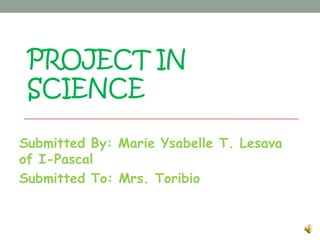
Earth's Motions Explained
- 1. PROJECT IN SCIENCE Submitted By: Marie Ysabelle T. Lesava of I-Pascal Submitted To: Mrs. Toribio
- 3. Earth’s Motion -There are two types of Earth’s motions and these are Revolution and Rotation.
- 4. Rotation • The Earth spins on its axis from West to East (counter-clockwise). • It takes the Earth 23 hours, 56 minutes, and 4.09 seconds to complete one full turn. • Day and night are produced by the rotation of the Earth. • The speed of rotation at any point upon the equator is at the rate of approximately 1,038 miles per hour, decreasing to zero at the poles.
- 5. •The Earth is rotating around an axis (called its rotational axis). The Earth's axis is tipped over about 23.5° from vertical. •The Earth’s rotation velocity at the equator is 1,674.4 km/h.
- 6. Seasons • The primary cause of the seasons is the 23.5 degree of the Earth's rotation axis with respect to the plane of the ecliptic. • This means that as the Earth goes around its orbit the Northern hemisphere is at various times oriented more toward and more away from the Sun, and likewise for the Southern hemisphere
- 7. Day and Night • These two are produced by the Earth’s Rotation. • As the earth spins one side is facing toward the sun (day) and the other side is facing away from the sun. (night) • The earth spins and the side of the earth that faced the sun now faces away, so the other side would be the day, while the other side would be night. • It takes 24 hours for the earth to spin around once.
- 8. Revolution • It is revolving around the Sun in a counter- clockwise direction. • It takes the Earth one full year to complete one full revolution around the Sun. • This path is known as the Earth's orbit. It is very near a circle, its elliptical. • The mean distance of the Earth from the Sun is about 93 million miles and the distance varies by 3 million miles, forming a slightly oval path.
- 9. • The revolution of the Earth around the Sun traverse a distance of 595 million miles in 365 days, 6 hours, 9 minutes and 9.5 seconds. • This means a speed of 18 miles a second (or 66,000 miles per hour) while at the same time rotating once each twenty-four hours.
- 10. Solstices • At two point through out the year, the tilt of the Earth’s axis reaches its maximum angle compared to the Sun, and begins to move back the other direction. • This usually happens around June 21st - the rays of the Sun shine directly on the Tropic of Cancer, and December 21st - the Sun’s rays shine on the Tropic of Capricorn.
- 11. Equinoxes • As the Earth moves around its orbit it reaches two points during the year where the tilt of its axis causes it to be straight relative to the Sun. • During these equinoxes the rays of the Sun shine directly on the equator. • This happens on approximately March 20th, and September 22nd.
- 12. Latitude • is the angular distance of that location south or north of the equator. The latitude is an angle, and is usually measured in degrees (marked with °). • The equator has a latitude of 0°, the North pole has a latitude of 90° north (written 90° N or +90°), and the South pole has a latitude of 90° south (written 90° S or −90°).
- 13. Longitude • is a geographic coordinate that specifies the east-west position of a point on the Earth's surface. • It is an angular measurement, usually expressed in degrees, minutes and seconds, and denoted by the Greek letter lambda (λ).
- 14. International Date Line • is a generally north-south imaginary line on the surface of the Earth, passing through the middle of the Pacific Ocean, where the date changes as a ship or airplane travels east or west across it. • It is roughly along 180° longitude, (opposite the Prime Meridian), but it is drawn with diversions to pass around some territories and island groups.
- 15. Prime Meridian • is the meridian (line of longitude) at which the longitude is defined to be 0°. • The Prime Meridian and its opposite the 180th meridian (at 180° longitude), which the International Date Line generally follows, form a great circle that divides the Earth into the Eastern and Western Hemispheres.
